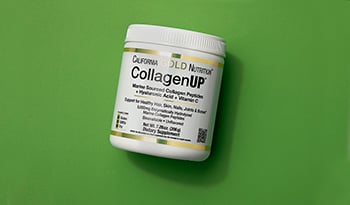What Is S-Adenosylmethionine (SAMe)? Benefits + More
DISCLAIMER:This blog does not intend to provide diagnosis...
- In this article:
- What Is SAMe?
- The Functions of SAMe
- SAMe Health Benefits
- SAMe Dosage
- Takeaway

What Is SAMe?
S-Adenosylmethionine, or SAMe. SAMe is formed from the combination of the essential amino acid L-methionine and adenosine triphosphate (ATP), the main “energy molecule” of the body.
SAMe plays an integral role in creating various hormones, neurotransmitters, and other critical molecules found in the body. SAMe is not only one of the most critical physiological substances in the human body, but it has also emerged as an important dietary supplemental form of L-methionine to support health.
The Functions of SAMe
In humans, SAMe is one of the most utilized compounds in enzymatic reactions in the body.[1]
About 30% of the total SAMe in the human body is found within mitochondria, the energy-producing compartment of cells.[2] This high concentration is no accident. SAMe is critical to helping fuel mitochondrial function. And that means it helps mitochondria produce the power that all cells need to function properly.
SAMe is also required to manufacture all sulfur-containing compounds in the human body, including glutathione, detoxifying compounds, and various sulfur-containing cartilage components, including chondroitin sulfate.
Perhaps the most well-known function of SAMe is that, along with folic acid and vitamin B12, it is critical to “methylation” reactions. Methylation is adding a single carbon unit (a methyl group) to another molecule. SAMe is often more effective in transferring methyl groups than other methyl donors. SAMe is the sole methyl donor involved in properly methylation of our genetic material (DNA, RNA, and histones). As a result, it plays a huge role in cellular replication and the expression of the genetic code. SAMe-mediated methylation reactions are critical in the manufacture of many body components, especially brain chemicals, active forms of nutrients and enzymes, and those used in detoxification reactions. B12 and folic acid are involved in methylation reactions and the manufacture of SAMe, so a deficiency of these nutrients can lead to disturbances in SAMe function.[3]
Another aspect of SAMe methylation is its importance in autophagy. This process translates to “self-eating.” Autophagy is the cell’s quality control process to dispose of cellular garbage, debris, microorganisms, and unwanted compounds as well as reuse those compounds that can be salvaged. Improved autophagy is associated with antiaging. In addition to improving the regulation of autophagy, SAMe is necessary for the metabolism of the nutrient spermidine, a key factor that enhances autophagy function.[4]
The bottom line is that the health effects of SAMe are far-reaching due to its central role in so many chemical reactions in the human body. Supplementation can provide insurance that enough SAMe is available to the body. SAMe has four primary uses as a dietary supplement: mood improvement, joint health, fibromyalgia, and liver support.
SAMe Health Benefits
Mood
SAMe has shown some benefits in supporting a positive mood in dozens of double-blind human studies.[5,6] In addition to generalized low mood status, SAMe has also been reported to produce significant effects in improving mood after childbirth and the stress associated with drug detoxification and rehabilitation. SAMe promotes a positive mood state via its ability to:
- Raise brain levels of serotonin, dopamine, and phosphatidylserine.
- Improve the binding of neurotransmitters to receptor sites, resulting in improved activity.
- Promote improved brain cell membrane fluidity and function.
In addition to its benefits on mood, studies also show that SAMe can be used with selective serotonin reuptake inhibitors (SSRIs) like Prozac, Zoloft, Paxil, etc. For example, in one double-blind clinical trial, 73 depressed patients were given 800 mg of SAMe or placebo twice daily for six weeks along with their SSRI.[7] The clinical response and remission rates were higher for patients treated with SAMe (36.1% and 25.8%, respectively) than the placebo (17.6% versus 11.7%, respectively). The side effects were no different in the SAMe than in the placebo group. These results indicate that SAMe can be used safely with SSRIs and may have a supportive effect.
Joint Health
SAMe has also demonstrated impressive results in supporting joint health. A deficiency of SAMe in the joint tissue, just like a deficiency of glucosamine, leads to loss of the gel-like nature and shock-absorbing qualities of cartilage. As a result, cartilage degeneration can develop, leading to pain and decreased joint function.
SAMe has been studied in 21,524 subjects with poor joint health in detailed double-blind clinical trials. SAMe has demonstrated similar reductions in pain scores and clinical symptoms in these studies to non-steroidal anti-inflammatory drugs like ibuprofen, indomethacin, naproxen, and piroxicam. While these drugs are associated with a significant risk of toxicity, side effects, and actual promotion of the disease process in osteoarthritis, SAMe offers similar benefits without risk or side effects.[8]
Two double-blind human studies deserve special mention. The studies were in patients with significant cartilage degeneration of the knee, and they compared SAMe (1200 mg/d) to the drugs nabumetone (Relafen, 1000 mg/d) and celecoxib (Celebrex, 200 mg/d). In the first study, SAMe was shown to be equal to nabumetone in effectively reducing pain intensity from baseline as well as in clinical assessments and index scores of joint function.[9] In the study comparing SAMe to Celebrex, SAMe showed a slower onset of action but was judged as effective as celecoxib, but without the side effects.[10]
Given the known risks for significant side effects with these drugs, the results from these studies provide additional evidence that an approach that focuses on delivering improved nutrition to joint tissues can provide considerable benefits to joint health.
Fibromyalgia
Fibromyalgia is a common condition that is associated with chronic musculoskeletal pain, depression, and fatigue. SAMe has been shown in double-blind human clinical studies to produce excellent benefits in patients with fibromyalgia. Improvements are noted by a significant reduction in the number of trigger points and painful areas and improvements in mood. SAMe appears to be a very important supplement in these patients.[11,12]
Liver Health
SAMe has been shown to be quite beneficial in supporting liver health. The benefits are related to its function as the major methyl donor in the liver and the promotion of detoxification reactions. Clinical studies have shown that SAMe is quite useful in protecting the liver from damage and improving liver function in conditions associated with fatty infiltration of the liver or estrogen excess due to oral contraceptive use, pregnancy, and premenstrual syndrome. SAMe is also beneficial in Gilbert's syndrome - a common syndrome characterized by a chronically elevated serum bilirubin level (1.2 to 3.0 mg/dL). SAMe supplementation significantly decreases serum bilirubin in patients with Gilbert's syndrome.[13,14]
SAMe Dosage
SAMe is usually recommended at 200 to 400 mg twice daily. SAMe rarely produces side effects other than occasional nausea and gastrointestinal disturbances. SAMe is considered safe during pregnancy and lactation. There are no known drug interactions with SAMe.
Takeaway
SAMe is a vital compound formed from L-methionine and ATP, crucial for hormones, neurotransmitters, and cellular function. It supports mitochondria, methylation reactions, autophagy, and overall health. SAMe supplementation may benefit mood, joint health, fibromyalgia, and liver health.
References:
- Lee YH, Ren D, Jeon B, Liu HW. S-Adenosylmethionine: more than just a methyl donor. Nat Prod Rep. 2023 Sep 20;40(9):1521-1549.
- Monné M, Marobbio CMT, Agrimi G, Palmieri L, Palmieri F. Mitochondrial transport and metabolism of the major methyl donor and versatile cofactor S-adenosylmethionine, and related diseases: A review†. IUBMB Life. 2022 Jul;74(7):573-591.
- Bottiglieri T. Folate, vitamin B₁₂, and S-adenosylmethionine. Psychiatr Clin North Am. 2013 Mar;36(1):1-13.
- Ouyang Y, Wu Q, Li J, Sun S, Sun S. S-adenosylmethionine: A metabolite critical to the regulation of autophagy. Cell Prolif. 2020 Nov;53(11):e12891.
- Peng TR, Cheng HY, Wu TW. S-Adenosylmethionine (SAMe) as an adjuvant therapy for patients with depression: An updated systematic review and meta-analysis. Gen Hosp Psychiatry. 2024 Jan 4;86:118-126.
- Cuomo A, Beccarini Crescenzi B, Bolognesi S, Goracci A, Koukouna D, Rossi R, Fagiolini A. S-Adenosylmethionine (SAMe) in major depressive disorder (MDD): a clinician-oriented systematic review. Ann Gen Psychiatry. 2020 Sep 5;19:50.
- Papakostas G.I, Mischoulon D, Shyu I, et al. S-adenosyl methionine (SAMe) augmentation of serotonin reuptake inhibitors for antidepressant nonresponders with major depressive disorder: a double-blind, randomized clinical trial. Am J Psychiatry 2010;167(8):942–948.
- Soeken KL, Lee WL, Bausell RB, Agelli M, Berman BM. Safety and efficacy of S-adenosylmethionine (SAMe) for osteoarthritis. J Fam Pract. 2002 May;51(5):425-30.
- Kim J, Lee EY, Koh EM, et al. Comparative clinical trial of S-adenosylmethionine versus nabumetone for the treatment of knee osteoarthritis: an 8-week, multicenter, randomized, double-blind, double-dummy, Phase IV study in Korean patients. Clin Ther 2009;31(12):2860–2872.
- Najm WI, Reinsch S, Hoehler F, et al. Harvey PW.S-adenosyl methionine (SAMe) versus celecoxib for the treatment of osteoarthritis symptoms: a double-blind cross-over trial. BMC Musculoskelet Disord 2004;26(5):6.
- Jacobsen S, Danneskiold-Samsøe B, Andersen RB. Oral S-adenosylmethionine in primary fibromyalgia. Double-blind clinical evaluation. Scand J Rheumatol. 1991;20(4):294-302.
- Tavoni A, Vitali C, Bombardieri S, Pasero G. Evaluation of S-adenosylmethionine in primary fibromyalgia. A double-blind crossover study. Am J Med. 1987 Nov 20;83(5A):107-10.
- Noureddin M, Mato JM, Lu SC. Nonalcoholic fatty liver disease: update on pathogenesis, diagnosis, treatment and the role of S-adenosylmethionine. Exp Biol Med (Maywood). 2015 Jun;240(6):809-20.
- Anstee QM, Day CP. S-adenosylmethionine (SAMe) therapy in liver disease: a review of current evidence and clinical utility. J Hepatol. 2012 Nov;57(5):1097-109.

 By Dr. Michael Murray, N.D.
By Dr. Michael Murray, N.D. 



